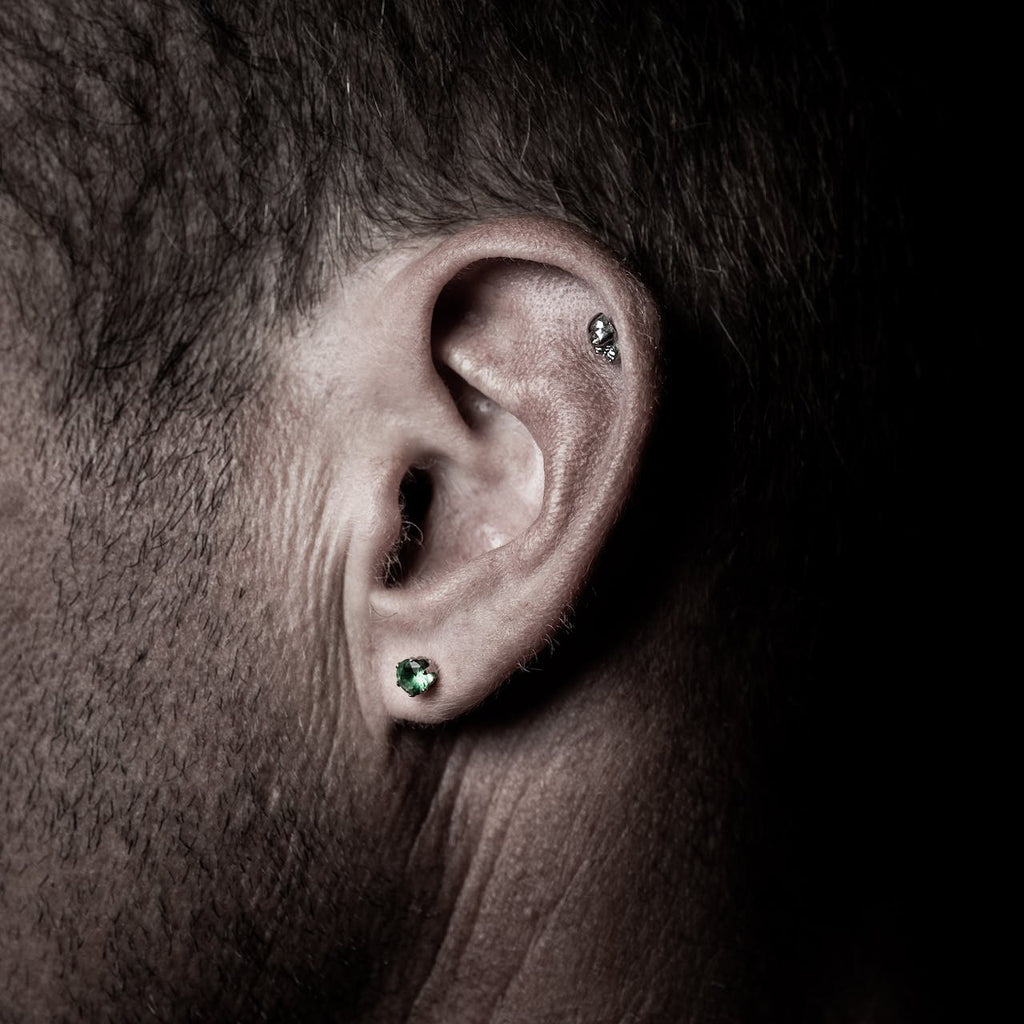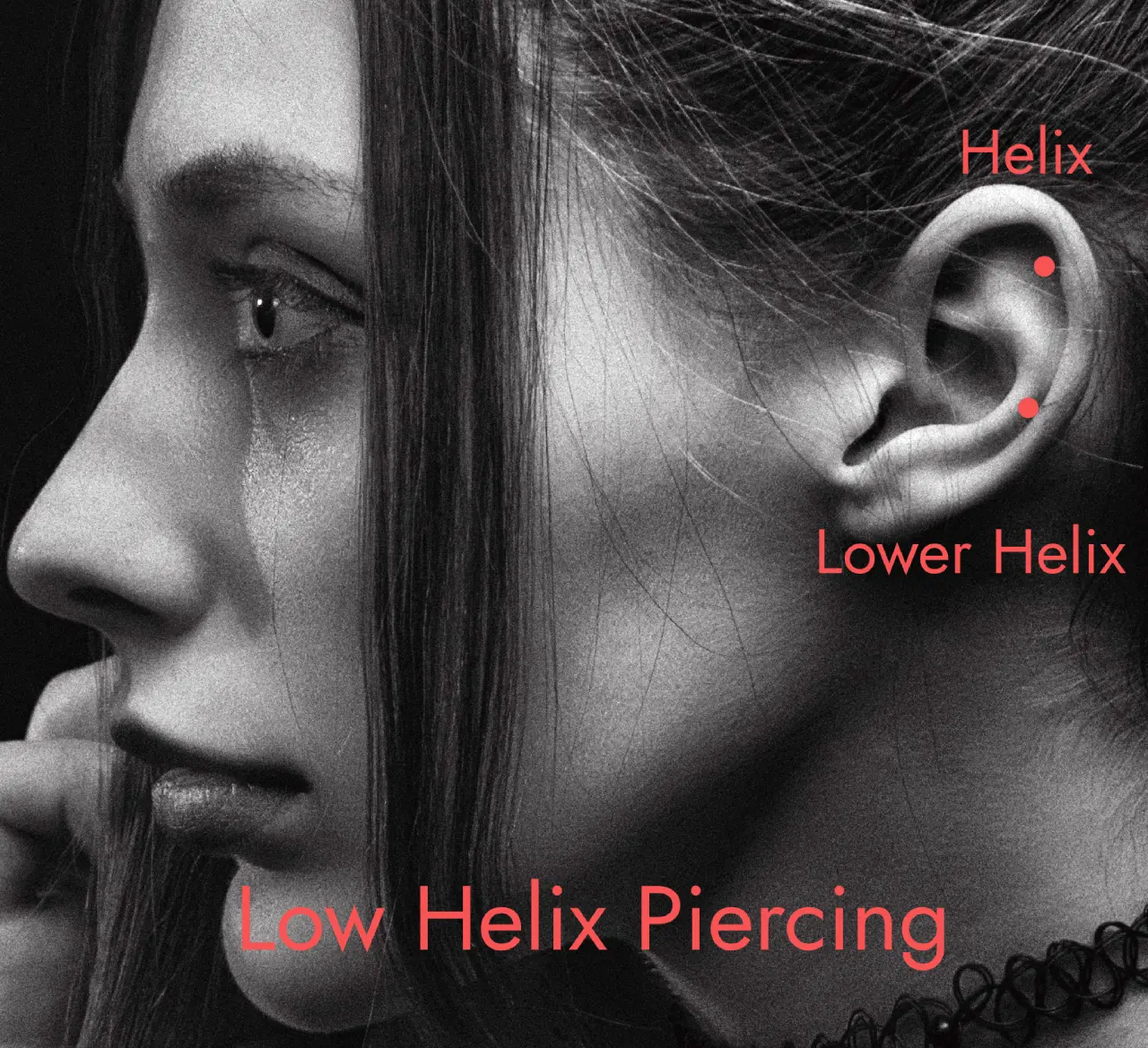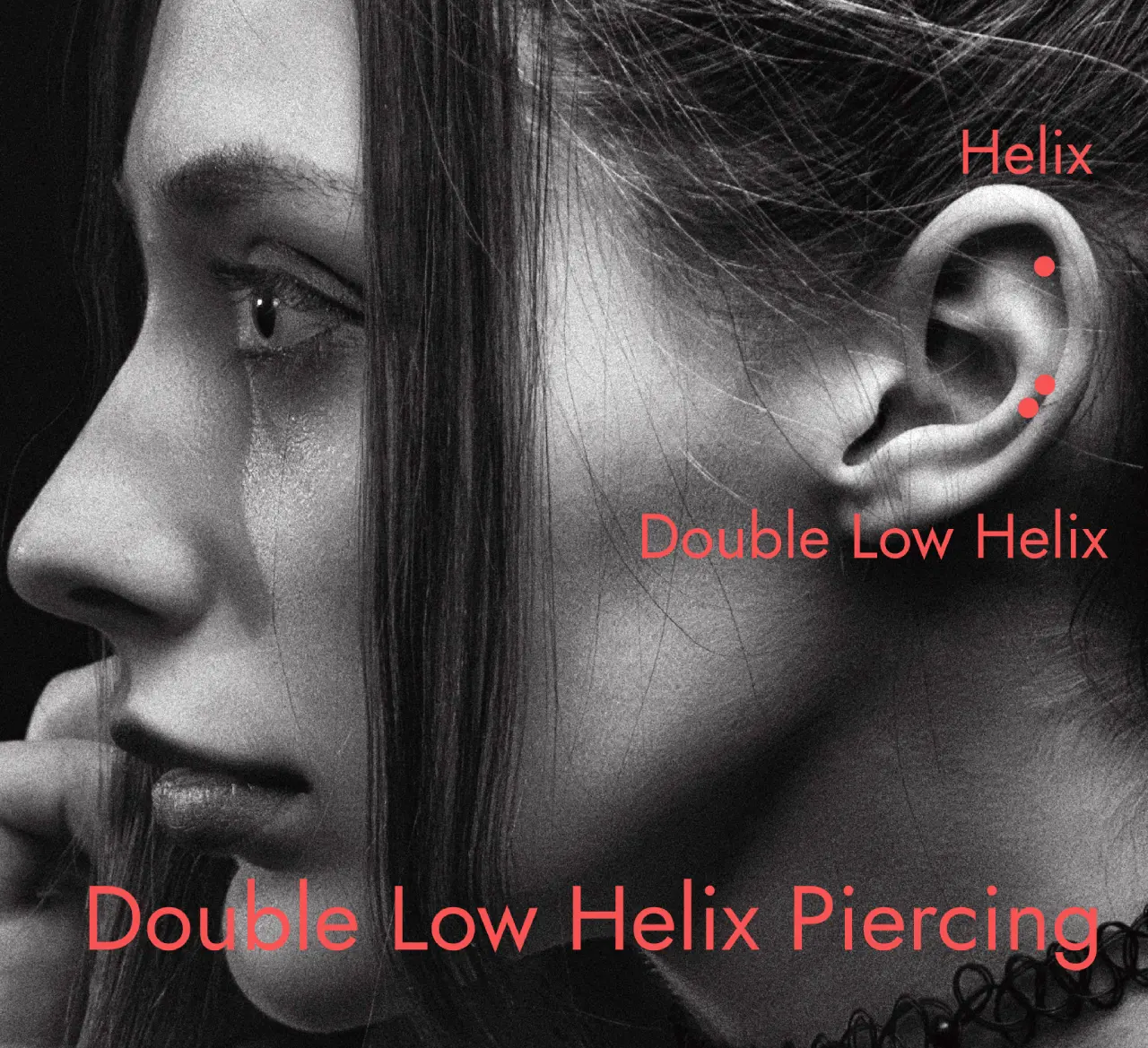Helix Piercing: Healing, Pain, Cost, Jewelry, Aftercare, Pros and Cons

If you love your earlobe piercings, it’s a natural next step to think about a cartilage piercing. There are many different parts of your ear cartilage that you can pierce, but one popular area is the upper half of your ear. This is called a Helix piercing.
If you’re thinking about getting a Helix piercing, learn more about the pain, how it heals, different placements, and what type of jewelry you can wear in it.
What Is a Helix Piercing?
A Helix piercing is a type of cartilage piercing done in the upper half of your ear. It can be a single piercing or multiple. It can also be positioned in various areas of your upper ear based on your preferences. Helix piercings may use hoops, studs, or other variations of jewelry.

Helix vs. Cartilage Piercing
A Helix piercing is a variant of cartilage piercing. While a cartilage piercing refers to any type of cartilage being pierced, a Helix piercing refers specifically to the upper half of your ear.
Types of Helix Piercings by Placement
A standard Helix piercing is located in the upper, outer portion of your ear. It’s usually at the tallest portion of your ear, where it begins to round inward toward your head.
That being said, Helix piercings can be located in various parts of your ear based on what you like best. Changing up the placement is a great way to customize for yourself.
1. Forward Helix Piercing or Front Helix Piercing

A Forward Helix piercing, also known as a Front Helix piercing, is done in the front cartilage of your ear right above your tragus. It’s positioned close to your head and usually fitted with a small stud because it’s a small area and requires an experienced piercer due to the placement’s complexity.
2. Outer Helix Piercing
Instead of piercing the front portion of your ear’s cartilage, the other Helix piercing goes through the outer cartilage of your ear. In other words, the jewelry is placed at the outer edge of the side of your ear.
3. Vertical Helix Piercing

A Vertical Helix piercing is located at the very top of your ear. It goes up and down through the cartilage at the top of your ear so the jewelry is placed in a completely vertical position. Studs are common for this piercing and some feature a dangling feature that will hang in the upper, inner portion of your ear.
4. Floating Helix Piercing

A Floating Helix ear piercing creates the illusion of a suspended earring. It sits at the upper cartilage of your ear above the helix rim. To create the illusion behind a floating helix, you must stick with certain jewelry styles.
5. Anti Helix Piercing
An Anti Helix piercing is also known as a Snug Piercing. This is the rounded ridge of cartilage across from your tragus. It’s not at the edge of your ear but goes in and out through the rounded piece of cartilage. It’s a harder, denser piece of cartilage that can be more painful than the outer area.
6. Low Helix Piercing

A Low Helix piercing is located just below the middle outer portion of your ear. It’s just above your earlobe where the cartilage begins.
7. Mid Helix Piercing
A Mid Helix piercing is located at about the middle outer portion of the ear. In other words, it’s in the cartilage directly across from the tragus. This is a common placement for a double or triple helix piercing.
8. Upper Helix Piercing
An Upper Helix piercing is located in the cartilage higher than the middle part of your ear. It’s higher than both the low and mid Helix piercing and is placed toward the top of your ear.
9. Auricle Piercing
An Auricle piercing is situated on the outer rim of the ear, lower than a standard helix piercing. The Auricle piercing is a variant of the Helix piercing and both have similar healing times and aftercare requirements.
The difference is that Auricle piercings are specifically placed in the middle of the ear and are less common.
Types of Helix Piercings by Quantity
There are numerous different variants of the Helix piercing. For example, a Helix piercing can have one, two, or three different perforations. If you love ear piercings, you may be interested in a double or triple helix so you can add more accessories to your ear.
1. Single Helix Piercing
A single Helix piercing is one piercing in the upper ear cartilage. It’s the standard style with just one piece of jewelry.
2. Double Helix Piercing

A double Helix piercing is two piercings in the upper ear cartilage. It involves two perforations right next to one another. Typically the jewelry should match with this type of piercing, such as two silver hoops, but you can ultimately wear whatever you’d like as long as they fit comfortably side by side.
3. Triple Helix Piercing
A triple Helix piercing is three piercings in the upper ear cartilage. It involves three perforations spaced evenly apart, but usually close to one another. Studs are a common type of jewelry for this piercing. For example, you could wear three diamonds that get gradually larger in size as you move down your ear.
Helix Piercing Healing Time
How long does a Helix piercing take to heal? Whereas lobe piercings often heal within a month, Helix piercings can take 6 to 9 months to fully heal. It may take longer if you experience complications.
There are fewer blood vessels in your cartilage than in your ear lobe which is what lengthens the healing time.
Helix Piercing Healing Stages
Once you get your Helix pierced, there are various stages to the healing process, including:
- Your piercing may start off swollen, sore, red, and hot to the touch.
- Swelling, redness, and pain should start to go down, though the area may still feel warm to the touch.
- There should be no discharge or bleeding and you may see minor flaking around the edges of the piercing.
- Once fully healed, there is no swelling, no redness, no flaking, no discharge, and the skin is not heated.
Helix Piercing Pain
Do Helix piercings hurt? On a scale from 1 to 10 with 1 being the least and 10 being the worst, people often rate a helix piercing at between a 4 and a 7.
However, you may experience more or less pain depending on your tolerance. Be sure to go to an experienced piercer, as they can lessen the potential pain by piercing quickly and efficiently.
How Much Is a Helix Piercing?
Helix piercings will vary in cost based on where you go. Typically, a Helix piercing will range from $30 to $75. Jewelry can make the price go up quite a bit depending on what you choose.
It’s best to go with a reputable piercer and high-quality jewelry, instead of just going with the cheapest options. This can help prevent infection and other complications.
Helix Piercing Jewelry
When choosing what type of jewelry you’d like for your Helix piercing, you need to consider the style, material, length, diameter, and gauge.
1. Types of Helix Piercings
You may get small rings, studs, or bars for your helix piercing. However, you must ensure it fits comfortably where it’s placed. You also may need to start with a stud and wait for the piercing to fully heal before swapping to a hoop.
Studs

Implant grade titanium stud earring heart-shaped flat back 16G $22.9, SHOP NOW.
You will likely start with a stud in your Helix piercing. The advantage here is they are better for healing than jewelry like hoops.
There is less pressure placed on the edges of the hole and it allows tissue to fill in the space between the stud and your ear. The downside is that piercing studs are often plain in appearance.
Straight Barbells

Piercing barbell 14g 16g titanium $17.9, SHOP NOW.
Many people switch out to bars or barbells when they remove their studs. You will find a large selection of lengths and gem sizes with bar jewelry. You can select shorter bars for a tighter fit too. Some feel that bars are commonplace, though, and look for more unique expressions.
Curved Barbells (Banana Barbells)

Curved barbell piercing ASTM F136 implant-grade titanium internally threaded $16.9, SHOP NOW.
Curved barbells are a popular choice for replacing piercing studs as well. They are a bit less common than straight bars, but that can mean less variety for gems and other decorative effects.
Many customers also prefer curved barbells as they feel the curve is more gentle on the piercing hole and it doesn't dig into the back of the ear like a straight bar can.
4. Mid Helix Piercing Hoop

Hoop piercing with CZ made of titanium $18.9, SHOP NOW.
Hoops are an interesting choice for the Helix piercings. Avoid them while healing, as they place undue pressure on the piercing hole walls and can cause more agitation from things like snags.
They can create visually stunning pieces, especially if you have a double or triple stack. It is likely the least used type in a mid-helix location.
2. Recommended Metals for Helix Piercings
Popular jewelry materials for Helix piercings include implant-grade titanium, 14K gold, and surgical stainless steel.
Implant-grade titanium is probably the best overall choice on the market. It is a lightweight metal that is hypoallergenic and corrosion-resistant.
That makes it ideal for initial piercing jewelry as it places less pressure on swollen piercing sites. You'll also find a wider variety of pieces made from this material because it is easy to shape.

Dangle helix piercing with clear CZ titanium drop earring 16G $22.9, SHOP NOW.
Stainless steel is durable and high-quality but does contain trace amounts of nickel that can be tricky for sensitive skin. Gold is softer and can also trigger skin allergies.
3. Helix Piercing Size
- Helix piercing gauge: Helix piercings are commonly 16 gauge (1.2mm) or 18 gauge (1mm).
- Diameter: If you go with a hoop, they can range in size from 1/8" (4mm) to 3/8" (10mm), depending on the thickness and anatomy of your ear. Standard sizes are 1/4" (6mm) and 5/16" (8mm).
- Post length: If you go with a stud, it can also range depending on the thickness of your ear, usually from 1/8" (4mm) to 3/8" (10mm). The standard size is 5/16" (8mm).
For information about other piercings please refer to our complete piercing size chart.
4. Jewelry for Forward Helix Piercing or Thin Helix
Since the cartilage for a Forward Helix piercing is generally thinner, the jewelry you need will likely only be 4mm (1/8") or 6mm (1/4") long. Common gauge sizes for Forword Helix piercings are 16G(1.2mm) and 18G(1mm), and the common diameter is 1/4"(6mm).
And since it’s in an area of your ear with limited space, you’ll likely need a flatback stud. This means the earring will go in from the back of the piercing and will be screwed on at the front.
When Can I Change My Helix Piercing?
You should wait until your Helix piercing is fully healed to change it. This typically takes between 6 months to 9 months. If you take your Helix piercing jewelry out too soon, it could introduce bacteria, irritate the piercing, get infected, and even close up.
How to Take Helix Piercings With a Flat Back Out?
To take out a flat-back Helix piercing, you must first wash your hands. Then, you will get a firm grasp on the back of the earring, holding it in place while you gently unscrew the front toward the left. Once the front piece of the earring has been unscrewed, you can gently wiggle out the stud, moving it backward out of your ear.
Helix Piercing Risks
As with any piercing, there are several potential risks of getting your Helix pierced. These may include:
- Infection: where there is oozing, pus, a foul odor, swelling, pain, and potentially a fever
- Bumps: where there is a hard, raised portion of skin, also known as a keloid
- Swelling: where the area is red and hot, which can be addressed with a cold compress
- Rejection: where your body rejects the piercing and it needs to seal up and be re-pierced, potentially in a different location
If you experience any symptoms of an infection or other complications, you should contact your piercer and a medical professional as soon as possible.
Helix Piercing Pros and Cons
There are several pros and cons of a Helix piercing. Some pros may include:
- It’s a fun piercing option that can compliment other piercings.
- You can get a double or triple helix design.
- There are various jewelry options to choose from.
- You can customize the look by choosing your placement.
- Once healed, you can switch out jewelry easily.
- Ear piercings are relatively easy to get and can be budget-friendly.
Some cons may include:
- They take longer to heal than ear lobe piercings.
- You need to wait for it to fully heal before changing the jewelry.
- They can be more expensive than an ear lobe piercing.
- They require attentive aftercare to help prevent infection.
- They could easily get caught in your hair or bother you when you sleep on your side.
How to Clean Helix Piercing?
It is recommended to use sterile saline that you buy from the store, rather than homemade saline, for cleaning your piercings. Homemade saline may be too salty for delicate piercing sites, leading to dryness and delayed healing.
Using mild, fragrance-free soap and water to clean your piercing site is also an option.
If you prefer homemade salt solution. You can start by mixing 1/2 teaspoon of non-iodized salt with one cup of distilled or boiled (for at least 20 minutes) water. You may choose to use less of the salt mixture like 1/4 to 1/8 teaspoon if you want a weaker solution that’s less likely to burn or sting. Stir the solution until it dissolves.
If you see signs of infection, you can also use antiseptic solutions, such as betadine, isopropyl alcohol, or diluted hydrogen peroxide. However, avoid using them for daily cleaning as they can damage cells.
Then proceed with the following steps to clean your piercing:
- Soak a cotton ball, a paper towel or non-plush cloth with the solution. Avoid fabrics that could snag and pull the jewelry or leave fibers behind. Gently saturate the piercing and cleanse it. Don't remove the jewelry!
- If you have a sterile saline wound wash that you buy from stores, then spay it while healing.
- Ensure you cleanse the piercing of any discharge or crusty material.
- Take clean gauze or cotton swabs and pat the area dry.
- Never scrub, poke, prod, or scrape at the piercing.
- Be sure to repeat this process at least 2-3 times a day or as advised by your piercer.
Your piercer should give you detailed instructions on how to keep your piercing clean once it has been placed.
Aftercare
- Avoid sleeping on the ear you had pierced.
- Take care to avoid contaminating the piercing.
- Avoid touching it or applying makeup very close to it.
- Avoid getting in the water that might be dirty.
- Clean your piercing twice per day using a saline solution made for wound cleaning or soap and water to prevent infection.
- Avoid ointments as they prevent necessary air circulation.
- And of course, make sure to avoid snagging on clothes or towels.
- Wear loose clothing. Avoid wearing tight clothing or clothing that may rub against the piercing, as this can cause irritation and slow down the healing process.
- Use hypoallergenic jewelry like implant-grade titanium and 14- or 18-karat gold. Surgical-grade steel may contain small amounts of nickel that could cause allergic reactions.
- Don't move the piercing unless you're cleaning it. Pulling on a piercing early in healing is painful, but it also can get in the way of healing or damage the piercing itself.
- Wait until your piercing heals before changing out your jewelry.
- Watch for potential signs of infection and consult your piercer or doctor if it becomes infected.
You should ensure you get pierced by someone experienced and reliable who utilizes the right cleaning and sterilization procedures. You’ll also need to choose high-quality jewelry that you aren’t allergic to. After you get your piercing, be sure to follow all instructions from your piercer.
Conclusion
If you’re thinking about getting a new piercing, a Helix piercing could be great for you. Check out different placement and jewelry options. Then, find a reputable piercer and make sure you fully understand all of the potential risks.
With the right aftercare, you could have a piercing that you’ll enjoy for years to come with various jewelry options to suit your personal style.
Read More
Floating Helix Piercing: The Complete Guide
Conch Piercing: Placement, Pain, Healing, Cost, Jewelry, Aftercare, Pros and Cons
Madonna Piercing: Everything That You Need to Know
Canine Bites Piercing: Pain, Cost, Healing, Jewelry, Sizes, Aftercare, Pros and Cons

















